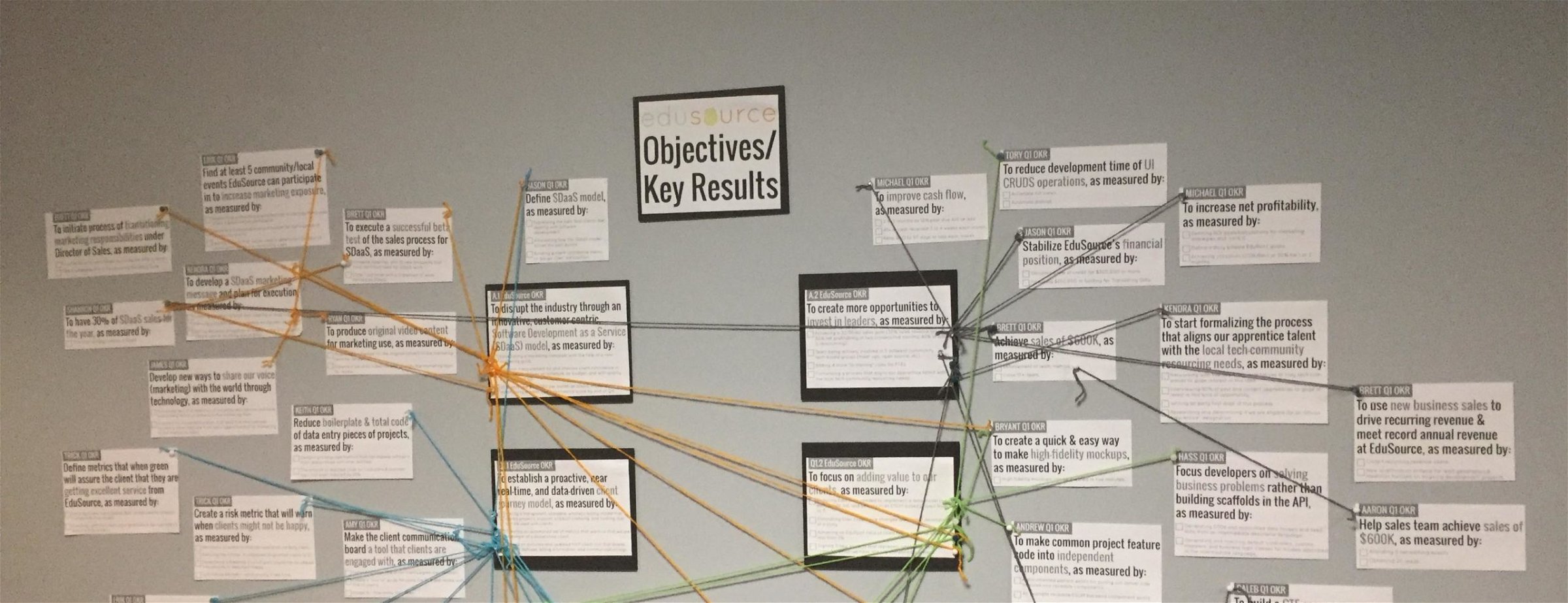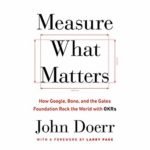
Objectives & Key Results
What led us to Objectives / Key Results (OKRs)? RoboSource has long emphasized goal setting. Each employee sets a quarterly goal, and we keep track them of their completion on an office wall. We celebrate when people meet them, and try again when they don’t.
But the process has been missing something essential: purpose. Employees would struggle to come up with something (anything!) to set as a goal. There was no larger purpose other than make oneself a better professional. There was no alignment with the rest of the company.
Enter our king of Kaizen, president Jason Beutler, who started researching better goal setting, and came across the idea of OKRs.
Objectives / Key Results aren’t magic. Really, all they are is a goal-setting tool that was first made popular by Intel and Google. But the more we read about them, the more it seems likely that OKRs will give us the purpose and alignment we need to take RoboSource to the next level. After much research and discussion, the Leadership Team decided to implement company-wide OKRs starting in January 2019. Thus our Leadership Team spent the fourth quarter trying to figure out how to make OKRs work at RoboSource. And, of course, determining our highest priorities for 2019.
Feel free to check back here, and we’ll update you quarterly on how our OKR journey is going. Our next step is an all-company OKR-setting party next Thursday. The intent is to not leave the office until everyone has set at least one approved OKR. And we’re doing a quick overview of OKRs to the company-at-large on Monday.
Before we jump into that, though, we thought it might be useful to round up the best of all the great articles we’ve been reading about OKRs, both for our readers who might be on similar journeys and our employees, some of who are just now hearing about OKRs for the first time.
 But before we go there, it’s only fair to give credit to the book that set us on this path, “Measure What Matters” by John Doerr. This book definitely served to whet our appetites for OKRs, but in the end, left us with more questions than answers. That’s why we turned to Google for more help. Here’s what we found:
But before we go there, it’s only fair to give credit to the book that set us on this path, “Measure What Matters” by John Doerr. This book definitely served to whet our appetites for OKRs, but in the end, left us with more questions than answers. That’s why we turned to Google for more help. Here’s what we found:
The Definitive Guide to OKRs by Atiim
This is probably the most comprehensive free resource out there, but you do have to fill out a form to get it. If you’re seriously thinking about implementing OKRs, I’d definitely recommend this resource. It breaks the whole process down to step-by-step, giving you a TON of information along the way. Seriously, this document is 39 easy-to-read pages, and it addresses things like history of OKRs, why you should use OKRs, how to use them, alignment, aspirational vs. operational, key tactics, grading, and more.
An excerpt: “OKRs are a modern solution to the goal-setting challenges that all growing companies face. OKRs considerably improve clarity, direction, focus, and communication. They will also improve alignment for everyone at your company, which is one of the biggest challenges in setting goals.”
How to Make OKRs Actually Work at Your Startup by First Round Review
This is a very hands-on guide to using Objectives / Key Results in a small business. It tells the story of Swipely, a small business that grew quickly, at least partly due to its use of OKRs. The article encourages small businesses to make OKRs their own in whatever way works for them, but gives guidelines that are “musts,” like having the ability to track results on a quantitative basis; making OKRs something people look at, every quarter, every week, every day; and ensuring that OKRs are a stretch. This is a longer read, too, but it’s a comprehensive guide. You could read just this one and have a pretty good idea of how to attempt OKRs.
An excerpt: “People love hitting their marks. Crossing off every to-do is always the goal. But when it comes to effective goal-setting, you should never get to 100%. If you do, you’re not trying hard enough. It’s not enough to say you want to see 10% improvement when you know that’s well within your reach. It means you’ll just keep doing the same things, just working ever so slightly harder.”
The Beginner’s Guide to OKR by Felipe Castro
Another great over-arching guide, this is another table-of-contents-type roundup, with 12 articles about various aspects of setting Objectives / Key Results. One of the more interesting is the “OKRs do not cascade” article, because this a line we’ve been trying to walk at RoboSource. How do you make goals align, but not cascade (so that a majority of goals start bottom up). This article was helpful, though we still aren’t sure how this works practically. We’ll let you know what we find soon!
An excerpt: “OKRs should be set in a parallel process in which teams define OKRs that are linked to the organization objectives and validated by managers, in a process that is simultaneously bottom-up and top-down. From the company OKRs, the teams can get a clear direction and understand how they can contribute to reaching those OKRs. Each team then defines a set of tactical OKRs for the quarter that contribute to the strategic OKRs and that roughly align with them.”
The Basics of OKR by Henrik-Jan van der Pol
This is a very brief overview of the OKR process, in the form of a slide deck. It will just take you a few minutes to browse through this deck, but it will give you a pretty decent overview of the topic.
An excerpt: “Objectives & Key Results: it’s a way to run your life, your team, or your company. It creates focus and prioritization. It aligns team effort and makes sure everybody is working toward the same goal.”
Again, check back with us at the end of Q1, and we’ll give you an update on how this is working for us. What about you? Are Objectives / Key Results something that you’re already using or could work for your organization?

Thank you for the great content! OKRs are really crucial for a company’s success. Here there is a blog post about the subject with some examples if you want to check it out https://corvisio.com/resources/what-is-okr/